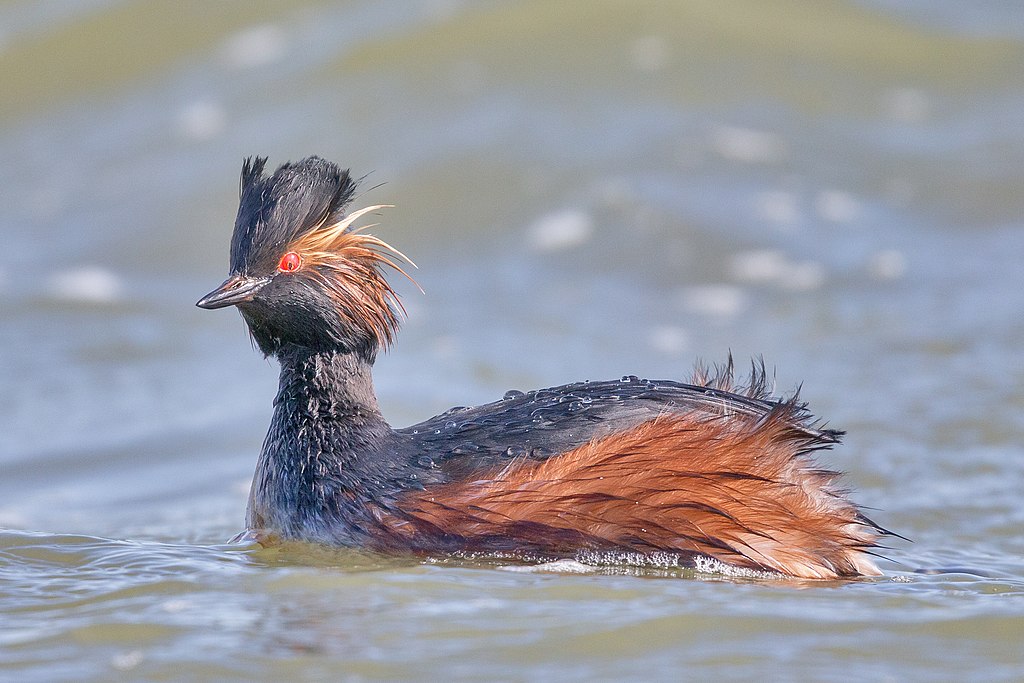Description

Disclaimer: Copyright infringement not intended.
Context
- In a rare bird sighting, a Black-necked Grebe was sighted in the Hokersar wetland.
Black-necked Grebe
- The Black-necked Grebe (Podiceps nigricollis) is a species of waterbird belonging to the grebe family.
Distribution:
- The Black-necked Grebe (Podiceps nigricollis) has a widespread distribution, inhabiting various regions across Europe, Asia, and Africa.
- Specific populations can be found in countries such as Spain, France, Turkey, China, India, and South Africa.
Habitat:
- Breeds in freshwater habitats such as lakes, ponds, and marshes with emergent vegetation.
- During the non-breeding season, they can be found in a variety of aquatic habitats, including coastal areas, estuaries, and inland waters.
Nesting:
- Construct floating nests made of plant material anchored to vegetation in the water.
- Typically lay a clutch of eggs, and both parents take turns incubating them.
Diet:
- Primarily carnivorous, feeding on fish, insects, and crustaceans.
- Skilled divers, capable of submerging and chasing prey underwater.

Migration:
- Some populations are migratory, traveling long distances between breeding and wintering grounds.
- Migration routes may include stopovers at suitable wetlands.
Territorial Behaviour
- Display territorial behavior during the breeding season, defending nesting sites.
Disease:
- The Black-necked Grebe, like many bird species, may be susceptible to diseases that can affect wild bird populations.
- Specific diseases could include avian influenza, botulism, and other waterborne diseases.
- Conservation efforts may include monitoring and managing disease risks, especially in areas with dense bird populations.
IUCN Status of Black-necked Grebe:
- Black-necked Grebe is generally assessed as "Least Concern" on the IUCN Red List.
- This designation suggests that the species is not currently facing a high risk of extinction.
- Ongoing monitoring of populations, habitats, and potential threats is crucial for maintaining the species' conservation status.
Hokersar Wetland
- Location: Hokersar Wetland is situated in the northern part of India, specifically in the union territory of Jammu and Kashmir.
- Proximity: The wetland is near the city of Srinagar. The Hokersar wetland, which is the largest bird reserve in the Kashmir Valley is situated in the Jehlum River basin.
- Aquatic Plants: Hokersar supports a variety of aquatic plants, including submerged and emergent species. These plants play a crucial role in providing habitat and food for the diverse fauna.
- Marsh Vegetation: The wetland area likely features marshy vegetation adapted to the fluctuating water levels.
- Avian Species: Hokersar is renowned for its significance as a bird sanctuary, hosting a wide variety of avian species, particularly during the migratory season. This may include waterfowl, waders, and other wetland birds.
- Migratory Birds: Many migratory birds, including ducks, geese, and waders, visit Hokersar during their annual migration, making it an important site for birdwatching and conservation.
- Fish and Invertebrates: The wetland provides a habitat for fish and invertebrates that form the basis of the food web.
- Ramsar Site: Hokersar Wetland has been designated as a Ramsar Site, indicating its international importance for the conservation of wetland ecosystems.

Threats of Hokersar Wetland:
Urbanization and Encroachment:
- Increasing human settlements and infrastructure development may lead to the encroachment of wetland areas, impacting the habitat for flora and fauna.
Pollution:
- Discharge of pollutants from nearby human activities, agriculture, or industries can degrade water quality, affecting the health of the wetland ecosystem.
Climate Change:
- Changes in climate patterns, including alterations in precipitation and temperature, can impact the hydrology of the wetland, affecting both flora and fauna.
Invasive Species:
- The introduction of invasive plant species can outcompete native vegetation, altering the wetland's ecosystem dynamics.
Over-Extraction of Resources:
- Overfishing or excessive harvesting of resources from the wetland can disrupt the balance of the ecosystem, affecting both flora and fauna.
Disturbance from Human Activities:
- Recreational activities, boating, or other forms of human disturbance can disrupt nesting and feeding behaviors of birds and other wildlife.
Addressing these threats requires a comprehensive conservation strategy, involving local communities, government authorities, and environmental organizations. It also emphasizes the importance of sustainable development practices to ensure the long-term health and viability of Hokersar Wetland.
|
PRACTICE QUESTION
Q. Consider the following statements:
1.Black-necked Grebe is considered as Critically endangered in the IUCN Red List.
2.Black-necked Grebe is primarily carnivorous, feeding on fish, insects, and crustaceans.
3.Hokersar Wetland is situated in the Jehlum River basin.
Which of the above statements is/are incorrect?
A) 1 only
B) 2 only
C) 3 only
D) All
Answer: A) 1 only
|












